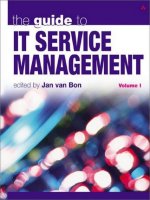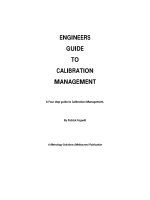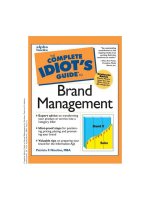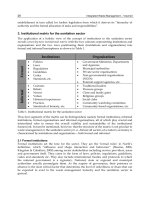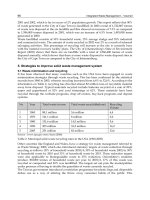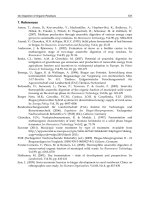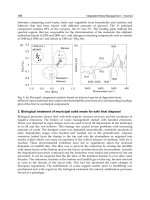The Guide to ITService Management Volume I pot
Bạn đang xem bản rút gọn của tài liệu. Xem và tải ngay bản đầy đủ của tài liệu tại đây (4.06 MB, 849 trang )
The Guide to
IT Service
Management
Volume I
8333 Prelims (i-xviii) 20/5/02 5:40 pm Page i
8333 Prelims (i-xviii) 20/5/02 5:40 pm Page ii
The Guide to
IT Service
Management
Volume I
edited by Jan van Bon
An imprint of Pearson Education
London
■
Boston
■
Indianapolis
■
New York
■
Mexico City
■
Toronto
■
Sydney
■
Tokyo
■
Singapore
■
Hong Kong
■
Cape Town
■
New Delhi
■
Madrid
■
Paris
■
Amsterdam
■
Munich
■
Milan
■
Stockholm
8333 Prelims (i-xviii) 20/5/02 5:40 pm Page iii
PEARSON EDUCATION LIMITED
Head Office
Edinburgh Gate
Harlow CM20 2JE
Tel: +44 (0)1279 623623
Fax: +44 (0)1279 431059
London Office:
128 Long Acre, London WC2E 9AN
Tel: +44 (0)20 7447 2000
Fax: +44 (0)20 7447 2170
Website:www.it-minds.com
First published in Great Britain in 2002
© Pearson Education Limited 2002
The right of Jan van Bon to be identified as author of this work has been asserted by him in
accordance with the Copyright, Designs and Patents Act 1988.
ISBN 0 201 73792 2
British Library Cataloguing in Publication Data
A CIP catalogue record for this book can be obtained from the British Library
Library of Congress Cataloguing in Publication Data
Applied for
All rights reserved; no part of this publication may be reproduced, stored in a retrieval system,
or transmitted in any form or by any means, electronic, mechanical, photocopying, recording,
or otherwise without either the prior written permission of the Publishers or a licence permitting
restricted copying in the United Kingdom issued by the Copyright Licensing Agency Ltd,
90 Tottenham Court Road, London W1P 0LP. This book may not be lent, resold, hired out or
otherwise disposed of by way of trade in any form of binding or cover other than that in which it
is published, without the prior consent of the Publishers.
Many of the designations used by manufacturers and sellers to distinguish their products are
claimed as trademarks. Pearson Education Limited has made every attempt to supply trademark
information about manufacturers and their products mentioned in this book.
10 9 8 7 6 5 4 3 2 1
Designed by Sue Lamble
Typeset by Pantek Arts Ltd, Maidstone, Kent.
Printed and bound in Great Britain by Biddles Ltd of Guildford and King’s Lynn.
Jan van Bon, chief editor of the Guide, can be contacted at
The Publishers’ policy is to use paper manufactured from sustainable forests.
8333 Prelims (i-xviii) 20/5/02 5:40 pm Page iv
Acknowledgements
x
Introduction to IT Service Management and the Guide
xii
Models for managing information systems
1
1 ASL, second-generation application management
7
Remko van der Pols and Machteld Meijer-Veldman
2 BDM®: IT-enabled business development and management methodolgy
24
Djoen Tan and Aad Uijttenbroek
3 BiOOlogic™
34
Johann Schreurs and DirkJan van der Hoven
4 C
OBI
T®
51
A.C.P. van Nijnatten, A.M. Dohmen and P.N.A. Broshuis
5 A model for functional management
70
Frank van Outvorst
6 The HP IT Service Management Reference Model
81
Jeff Drake
7 IPW™ and IPW Stadia Model™
97
Hans van Herwaarden and Frank Grift
8 Integrated Service management (ISM)®
116
H. van den Elskamp, W.J.J. Kuiper, H. Wanders, J. van Bon and W. Hoving
9 ITIL: best practice in IT Service Management
131
Lex Hendriks and Martin Carr
10 Information Technology Process Model
151
Paul Hertroys and Bart van Rooijen
11 A ‘Managerial Step-by-Step Plan’
158
Maarten Looijen and Wouter de Jong
12 Managing the delivery of business information
165
Leo Ruijs and Albert Schotanus
part 1
Contents
8333 Prelims (i-xviii) 20/5/02 5:40 pm Page v
13 MIP: managing the information provision
178
Dirk Jan van der Hoven, Guido Hegger and Jan van Bon
14 Microsoft Operations Framework (MOF)
190
Dave Pultorak
15 The SIMA: a practical approach to information technology management
204
Louis van Hemmen, Michiel Borgers and Rick Klompé
Review of part 1
216
Sourcing and procurement
227
16 Methodological ERP acquisitions: the SHERPA experience
231
Joan A. Pastor, Xavier Franch and Francesc Sistach
17 Relationship management: delivering on the promise of outsourcing
247
John Buscher
18 Chinese walls in IT outsourcing
263
Roger Leenders, Johan Duim, Albert van Houwelingen, Mario Paalvast
and Gregg Shaffer
19 Best practice in acquisition and procurement management:
the Information Services Procurement Library
277
John Dekker and Lex Hendriks
Review of part 2
297
Metrics
299
20 Enforcing performance guarantees based on performance service levels
302
André Scholz and Klaus Turowski
21 GQM applied in IT Service Management
312
Wouter de Jong
22 Service level measurement: checkpoint 2000
324
Mike Tsykin
23 How to improve the quality of your support centre by certification
335
Eppo Luppes, Bill Sheehan and Jackie Kuflik
24 A standard for IT Service Management
344
Jenny Dugmore
Review of part 3
358
part 3
part 2
The Guide to IT Service Management Volume I
vi
8333 Prelims (i-xviii) 20/5/02 5:40 pm Page vi
Maturity
363
25 The future of the IT organization
366
Guus Delen, Mark Griep, Daam Grund and John Roelofs
26 Professionalization of ICT-management organizations:
a roadmap for ICT managers
383
Gertrud Blauwhof, Christine Praasterink, Frank van Outvorst,
Leen van Stappen, Marco Postma, Ger Manders and Wim van Haaren
27 Improvement of the test process using TPI®
408
T. Koomen and M. Pol
28 Securing information now or never
420
Anton Griffoen and Jaap van der Wel
29 Quality of software development
431
Paul Hendriks
Review of part 4
442
Processes
447
30 Service Level Management
450
Rocky Kostick, Justin Williams and Matt Arnold
31 An integrated environment for managing software maintenance projects
460
Francisco Ruiz, Mario Piattini and Macario Polo
32 Kwintes project: results of a multidisciplinary research project in the
field of IT Service Management
478
L.J. Ruijs
33 Integrated life-cycle management
Wim van den Boomgaard and Ton Pijpers
489
34 Hunting the mammoth
507
Jan F. Bouman and Michel van Dijk
Review of part 5
519
Organizational aspects
521
35 Embedding and managing IT processes in an organization
525
Richard van Bavel and Jeroen Bronkhorst
36 Patching the blind spot in implementation of IT process models
542
Peter A.J. Bootsma and Jan van Bon
37 Competence management
558
Renée Kamphuis
part 6
part 5
part 4
Contents
vii
8333 Prelims (i-xviii) 20/5/02 5:40 pm Page vii
38 Knowledge management and the IT Service Management organization
567
A.P. Kuiper, P.M. Los and J. Sietsma
39 Organizational improvement and culture … growth deserves space!
583
Jolanda Meijers and Hans van Herwaarden
Review of part 6
593
Practical guidance
599
40 The process approach: managing chaos?
604
Frank van Elsdingen and Bram de Landtsheer
41 IT Service Management: the IT management ERP solution
617
Michael D. Loo
42 End-to-end Service Level Management
627
J. den Boer, P.R. Leeuwenburg, J.J. Vilé and A.C. Otterman
43 IT Service Management: a pragmatic direction
642
John Gilbey
44 Beauty is in the eye of the beholder
651
Barry J.M.A. Meesters and Jan F. Bouman
45 Service Level Management
667
Peter Sullivan
46 The management of IT service expectations
678
Rhion Jones and Mike Fox
47 Is there life after ITIL?
687
Lisette Favier
48 Russian roulette
698
Dick Costeris
Review of part 7
713
E-management
719
49 Service Management and the Internet: managing e-services
721
Jeroen Wiebolt and Ingewang Wong
50 Management of a website: what’s new?
731
C.D. Deurloo, R.J.C. Donatz, R. van der Pols and F.J. Snels
part 8
part 7
The Guide to IT Service Management Volume I
viii
8333 Prelims (i-xviii) 20/5/02 5:40 pm Page viii
51 Vision in the BLUR of eManagement
742
Michiel Borgers and Paul van der Spek
Review of part 8
753
Tools and instruments
755
52 Enterprise Management Software implementation
757
Niranjan Prasad, Sankaran Velunathan and Shyam Sundar V
53 A business-focused Service Level Management Framework
778
Paul Maestranzi, Ron Aay and Richard Seery
Review of part 9
799
Compendium for IT Service Management
801
54 IT management glossary
802
part 10
part 9
Contents
ix
8333 Prelims (i-xviii) 20/5/02 5:40 pm Page ix
Many experts from the field of IT Service Management have assisted in putting
together this first edition of The Guide to IT Service Management Volume I. Without
these authors, who have done a lot of work to formulate their knowledge and insights
and put them down on paper, a book like this would not be possible. I owe these
authors my gratitude. The names of the authors are mentioned in their respective con-
tributions, but you can be assured that many more were involved in the writing and
evaluating of the final texts.
The authors of the chapters in this Guide are not the only ones who have put effort
into this book. Many others wrote proposals that didn’t make it. Only part of those pro-
posed chapters were rejected for reasons of quality or because they fell outside the
scope of the book we wanted to make. The other major reason for rejection was the lim-
itation on size. We think that the Guide has the right number of contributions for a first
edition. Depending on the way the Guide is received, we will determine the structure
of the next edition. For that reason all readers are invited to give their feedback to the
editor in chief, preferably by e-mail: We hope that many of the authors
whose articles were not selected for this edition will be willing to try again for the next
edition. To make a well-balanced Guide it is necessary to have a great number of pro-
posals. Those proposals reflect the highlights of the global interest in this field and
make it possible to choose the best-fitting contributions for the final book.
Another group of people who played a major role in composing this Guide was the
Advisory Board. To build a true world-class Guide we needed a selection mechanism
for the proposals that reflected a global perspective on the subject of IT Service
Management. Therefore we set up an international Advisory Board, consisting of a
great number of specialists from all over the world. The members of this Advisory
Board have been reading all proposed contributions, which were made completely
anonymous. All these proposals were carefully evaluated. From the comparison of
these evaluations, which reflected the views of a very diverse group, the final selec-
tion of papers was made. I thank the members of this Advisory Board especially for
their sophisticated and unbiased evaluations, in alphabetical order:
CCTA/OCG, Best Practice Division: John Groom
Compaq Computer Corporation, Operations Management Services: Sjaak van den
Broek
Ernst & Young, Information Technology Infrastructure: Theo Schrammeijer
EXIN, Examination Institute for Information Science: Lex Hendriks
x
Acknowledgements
8333 Prelims (i-xviii) 20/5/02 5:40 pm Page x
GartnerGroup, Research Advisory Service: Colleen Young
Hewlett-Packard: Chris Harris
IBM, Global Services EMEA: Juan Antonio Zufiria
ITSMF-Americas: Ken Hamilton
ITSMF-Australia: Bob Philipson
ITSMF-Belgium: Stef Knaepkens
ITSMF-International: Jos Brusse
ITSMF-South Africa: David Cannon
ITSMF-Switzerland/Austria/Germany: Walter Vogt
ITSMF-The Netherlands: Foppe Vogd
ITSMF-United Kingdom: Aidan Lawes
META Group, Services Management Strategies: Stratos Sarissamlis
University of Technology Delft, Information Strategy and Management of Information
Systems: Maarten Looijen
Creating a Guide like the one you have before you now takes quite an effort, which one
shouldn’t take on alone. I couldn’t have done this without the help of my two col-
leagues Wil Haasdijk and Rolf Akker, who were a great help in managing and editing
the content of the Guide. I owe them my respect.
Finally I want to thank Ivo van Haren, professional publisher and personal friend,
who stimulated me to develop this Guide. Ivo finds a real challenge in the distribu-
tion of knowledge in the discipline of IT Service Management. He has made a
difference by helping me to overcome a lot of hurdles that an editor encounters on the
road to publishing a complex book.
Jan van Bon,
Chief editor,
May 2002
Acknowledgements
xi
8333 Prelims (i-xviii) 20/5/02 5:40 pm Page xi
The importance of IT Service Management is becoming widely recognized. Whereas
in the 1960s and 1970s interest was still focused mainly on the improvement of hard-
ware, and whereas the development of software was the major concern until well into
the 1980s, the 1990s was the decade that saw the rise of service management.
For decades, Service Management had been seen as an extension of development,
more of a necessary evil than a valuable element in automation. But recent years have
been characterized by a turnaround in this view, supported not least by Gartner Group
publications, which show that around 70–80 percent of the life-cycle costs of an infor-
mation system are incurred in the exploitation phase.
This shows that the exploitation area is a rewarding area of activity when it comes to
cost control. This is further supported by the discovery that developers spend around 60
per cent of their time on maintenance. In addition, it is evident that there is a strong
growth in the awareness that many primary business processes can no longer function
without the contributions made by information systems; in many industries, IT is
already one of the primary business processes. Think, for instance, of telecommunica-
tions, banking, insurance and other data-intensive industries. The developments in
e-commerce also show that IT has become a crucial factor for operational management.
And on closer inspection it will be found that the main day-to-day activities of a very
large number of IT staff seem to consist of management activities. Therefore the business
needs to get control of information technology and the services based on it.
All in all, there is a flood of signals showing that the organization of IT Service
Management is a field to which very careful attention should be paid. And this is in a
world that is characterized by an avalanche of technological developments and increas-
ing demands on the time-to-market, flexibility and performance of information systems.
>> Motivation for the Guide
The motivation for compiling The Guide to IT Service Management came up some years
ago, when the editor became aware that a clear synchronization in the development of
concepts on the theme of IT Service Management was taking place in part of Europe.
However, there was still no question of worldwide synchronization. Quite the contrary:
further investigation showed that different approaches to implementing care for the
quality of information provision were to be found in different parts of the world.
On the basis of discussions with the IT Service Management Forum (ITSMF), the first
steps towards this Guide were taken in 1998. The publication of this Guide is intended
to make information on the various approaches to IT Service Management more gener-
ally available and to provide a platform on which concepts can develop. The very latest
developments in the subject can be followed continuously in editions to be brought out
xii
Introduction to IT Service
Management and the Guide
8333 Prelims (i-xviii) 20/5/02 5:40 pm Page xii
annually. In addition, discussion of the developments identified and the various
approaches to them will be encouraged in international discussion forums on the
Internet (). This combination of initiatives can make a contribution
to the desired global synchronization of concepts in the field of IT Service Management.
>> Scope of the Guide
The subject of this Guide is IT Service Management. But what is IT Service
Management? There are many definitions, of which I prefer the following: ‘IT Service
Management is a set of processes that cooperate to ensure the quality of live IT serv-
ices, according to the levels of service agreed with the customer.’ It is superposed on
management domains such as systems management, network management, systems
development and on many process domains such as change management, asset man-
agement and problem management.
This new specialist area is gradually becoming fully mature. This can be seen, for
instance, from the fact that different theoretical frameworks with substantial content
are coming into existence alongside each other. Theory formation is always a sign of
the growth of a specialist area. We also see this in the discipline of IT Service
Management. In the relatively short history of the field of IT Service Management, one
approach has managed to become established as the de facto standard in several coun-
tries: ITIL, the IT Infrastructure Library. The market in a rapidly increasing number of
countries is focused on the application of this approach at present. But there are also
various other methodological approaches, which you will find listed in this book.
Many of the approaches have a strong relationship to the best practices defined in
ITIL and continue to embroider on that theme. Each of the approaches has its own
advantage in different situations.
>>
Standardization and certification
As is usual in the development of a ‘new’ discipline, regulations and standardization
are following some distance behind practice. Therefore there is still hardly any regula-
tion on the part of government and the standardization organizations in this case. The
concept of a ‘standard’ does not go much further than a de facto standard such as ITIL.
The only formal regulation which can be applied is effectively the antiquated ISO
range. Although not specifically designed for the management area, many regulations
apply to a wide quality area, and so also to IT Service Management. But certification
initiatives relating to management organizations are beginning to appear here and
there. In addition, a number of initiatives for individual-oriented certification are to
be found in the Service Management field. These are the first signs that standardiza-
tion is arising. It is still too early to say what form of certification will lead to
standardization in the longer term. Certification indicates a stable situation:
●
Individual-oriented
: the job must be generally recognized and acknowledged. The
professional group must be homogenous and measurable.
●
Organization-oriented
: there must be a stable picture of what the organization is, its
goals, performance pattern etc.
Introduction to IT Service Management and the Guide
xiii
8333 Prelims (i-xviii) 20/5/02 5:40 pm Page xiii
There is no point in certification if a stable situation of this kind has not been
achieved. After all, in that case the value of the certificate will not be recognized; it is
not founded on the recognition of a goal to be pursued. It is quite evident that the
desired stability is not yet within the reach of the field of IT Service Management.
Metrics (Part 3 of this book) deals in more detail with recent developments.
>>
Missing dictionary
While the subject is flourishing, there are also some teething troubles for this rela-
tively young discipline. One of these is the lack of a settled, stable, terminology
framework. There are synchronized definitions across the world for many technical
terms, but when two IT specialists speak about issues such as ‘management’, ‘prob-
lem’, ‘application’ or ‘infrastructure’, just to take some obvious terms, there is
immediately an enormous risk that they each have a different semantic framework
and have different meanings in mind, with all the negative consequences this
involves. This has resulted in the development of a standard terminological frame-
work in the Netherlands, one of the first countries to fully adopt ITIL and IT Service
Management practices since the early 1990s. The definitions and the framework are
part of this Guide, and they will help you to get acquainted with new terminology.
>>
Industry formation
The fact that the field of IT Service Management is experiencing strong growth is also
evident from the development taking place in dedicated industry organizations in this
area. The explosive growth of an organization such as the IT Service Management
Forum is typical. Specialized organizations such as the Help Desk Institute (HDI),
Help Desk 2000, ISACA and the International Information Systems Security
Certification Consortium (IISSCC) are also showing a growth which is providing a
higher profile for sections of the specialist area. Just recently an initiative of market
leaders and infrastructure organizations in the IT services branch has led to installing
a new IT Service Fund. The Fund, managed by leading authorities in the IT services
industry, will stimulate and finance initiatives that will benefit the IT services market
and emphasize its innovative nature.
>>
Organization of the Guide
This Guide is an international publication in the field of IT Service Management, after
the example of the Dutch IT Beheer Jaarboek, the IT Service Management Yearbook.
This Yearbook has been published annually since 1997 and is a highly appreciated
source of state-of-the-art insights, methods, glossaries, cases etc. in the field of IT
Service Management. This Guide to IT Service Management will also be published regu-
larly. The book is a compilation of chapters contributed by researchers and practitioners
addressing issues, trends, and challenges facing the management of IT services.
The Guide was created by distributing a worldwide call for chapters on a large scale.
From the proposals which were submitted for the Guide, a series of 53 were selected in
an intensive selection process. Selection was carried out according to strict standards;
The Guide to IT Service Management Volume I
xiv
8333 Prelims (i-xviii) 20/5/02 5:40 pm Page xiv
there was an international editorial board consisting of specialists from various organi-
zations: ITSMF representatives, global research and consultancy organizations, global
providers, examination institutes, quality organizations and universities. The partici-
pating organizations were OGC (formerly CCTA, UK), Delft University of Technology
(NL), Compaq, IBM, HP, Ernst & Young, Meta Group, Gartner Group, EXIN (NL) and
representatives from ITSMF Chapters in the United Kingdom, the Netherlands, the
United States, Switzerland, Germany, Austria, South Africa, Australia, Belgium and the
umbrella organization ITSMF International. This board received a large number of
totally anonymous proposals for contributions to the Guide. On the basis of its com-
mentaries on the subject content, a selection was made and the authors then further
developed their contributions. This method has ensured that the texts you now have in
front of you are the most interesting ones we gathered worldwide. The fact that a strik-
ingly large proportion of the authors are from Dutch organizations not only shows the
importance attached to the field in that country, but also illustrates the stage of devel-
opment it has progressed to in the Netherlands. It is also noticeable that two or more
contributions have been included by some organizations from various countries (HP,
KPN, Origin, PinkRoccade, Quint Wellington Redwood, The Art of Service). The
anonymous treatment of the proposals means that this reflects these organizations’ con-
centration on the theme of IT Service Management.
>>
Publications in the Netherlands
In the Netherlands, the fast-growing demand for information sources about this sub-
ject has led to the development of the Annual Yearbook and various other books, two
dedicated magazines (IT Beheer Magazine and IT Service Magazine), a series of pocket
guides (ICT Management Pocket Guides) and the development of a website dedicated
to the subject of IT Service Management (
). After a cautious start
in 1997, the later editions of the Yearbook captured tremendous attention. Over a
short period of time, the book has been acknowledged as the standard work on IT
Service Management in the Netherlands. The main reason for this success is believed
to be the simple and thorough entry level this book is offering to newcomers as well
as to experienced service management specialists regarding the question ‘What is IT
Service Management all about?’. The book does not contain in-depth studies of spe-
cific processes in the same way that ITIL does, but instead offers an overview of the
model-wise approach one could use in implementing a service management strategy.
It also presents an annual hot-list of items which have drawn serious attention.
The main part of the Dutch Yearbook discusses approaches for IT Service
Management (next to ITIL), as well as other methods that build upon ITIL, and it
describes the main benefits in a wider context.
Furthermore, the book contains a compendium: a glossary of IT Service
Management terminology. This glossary was based upon: a thorough survey of several
hundred companies in the Netherlands; ITIL documentation; and several existing glos-
saries derived from international sources. A Compendium Committee is reviewing the
glossary on an annual basis.
This historical sketch emphasizes the great attention IT Service Management has
been receiving in the Netherlands. Although it is hard to find an explanation, the sub-
Introduction to IT Service Management and the Guide
xv
8333 Prelims (i-xviii) 20/5/02 5:40 pm Page xv
ject is very much more alive in the Netherlands than in most other countries.
Therefore, you will find a relatively high proportion of Dutch sources among the con-
tributions in this Guide. This emphasizes – taking into consideration the broadly
international face of the editorial board that was used to select the anonymous pro-
posals for this Guide – the ideas developed in the productive Dutch Service
Management climate.
>>
Structure of the Guide
The Guide begins in
part 1
with a survey of methodological approaches to designing
IT Service Management. In the frameworks presented, considerable use is made of in-
house vocabulary. For example, the terms ‘IT’ and ‘ICT’ are used as synonyms,
depending on the preference of the various authors. There is a range of different
emphases in the frameworks, and in some cases the framework has more the character
of a vision while in others it is a fully fledged method. The frameworks will be of
varying use in different circumstances, depending on the reader’s local situation.
The Parts following this are subdivided by theme. An important trend is dealt with
in
part 2
; because of the increasing complexity and the high demands placed on serv-
ice provision, more and more companies are faced with the question of whether to do
it themselves or outsource it.
Part 3
contains contributions dealing with the real need for quantification. It is nec-
essary for us to learn to deal with measurable variables (metrics) so that we can render
the service provision quantifiable and be able to direct the required improvement in
its quality.
Part 4
goes into the issue of quality improvement in IT service organizations. A
stepwise improvement approach often leads to what has been recognized as the
‘maturity’ of the organization.
In
part 5
you will find an elaboration of some of the most important single
processes in IT Service Management.
Part 6
deals with an aspect of IT Service Management which is attracting increasing
interest. The less hard aspects of the field are increasingly coming to be recognized as
important variables within a service provision company. Whereas other industries
have already been working with this awareness for many years, the IT service indus-
try still has a lot to learn in this area. And this is particularly difficult for an industry
which is characterized by people who have come into the field because of a mainly
technological interest.
Part 7
provides a number of practical illustrations and aids for the application of
various frameworks. These contributions bridge the gap between theory and practice.
They will provide you with valuable ideas on how other organizations have solved
their service management problems, emphasizing the aspect of organizing people.
Part 8
deals with the latest development in e-business: what are the effects of e-
business developments on the solutions we found in the ‘traditional’ IT world?
In
part 9
, we present some structures for the matter of tooling, found to be so very
important in many organizations.
We finish the Guide with the Compendium for IT Service Management,
part 10
.
The Compendium defines hundreds of terms used throughout this Guide. The
The Guide to IT Service Management Volume I
xvi
8333 Prelims (i-xviii) 20/5/02 5:40 pm Page xvi
Compendium doesn’t have an official status but reflects most of the terms used in an
integrated and consistent way. It covers various IT service management domains and
is compatible with ITIL and the Delft school.
>> Target audience and ambition
The intention in preparing this Guide is to make a contribution to the development of
concepts in the field of IT Service Management. By exchanging experiences and
insights on these subjects, IT specialists in all parts of the world can find out about
the relevant developments which are taking place in the field. The inclusion of a
wide, representative range of concepts from different parts of the world enables read-
ers to follow up those matters which are in line with the approaches appropriate for
their cultures. It is hoped that by including these carefully selected contributions in a
single book, there will be a kind of ‘mutual infection’ which will stimulate and syn-
chronize developments in the field. This book contains instructive elements for
everyone involved in the organization and delivery of IT services, and so its target
audience includes the majority of people working in IT. Because of the growing
awareness that the function of IT is solely to support the primary business processes,
it can be expected that the frameworks provided for that purpose in this Guide will
make a useful contribution to the development of state-of-the-art IT service providers.
Introduction to IT Service Management and the Guide
xvii
8333 Prelims (i-xviii) 20/5/02 5:40 pm Page xvii
8333 Prelims (i-xviii) 20/5/02 5:40 pm Page xviii
part 1
Models for managing
information systems
>>
Introduction to the theme
The importance of IT Service Management is increasingly recognized and acknowl-
edged. This is evident, for example, from the number of periodicals, publications and
events in this area. That is a logical consequence of the amount of money being spent
on IT Service Management; the costs of management and maintenance are a multiple
of the development and implementation cost. As an extension of this development,
many suppliers and large user organizations have developed methods to give shape to
IT Service Management. Further analysis of these methods shows that there is a great
deal of overlap, but also many differences: management processes are named and
sequenced in a particular way, the IT Infrastructure Library (ITIL) and the Capability
Maturity Model are followed to a greater or lesser extent, and the objects to be man-
aged are arranged in different ways.
Readers will find the concepts presented more or less immediately accessible
depending on their local situation. But the wide variation in what is included makes
it very improbable that among all the frameworks presented not one way of thinking
will be found which is in line with the reader’s view or can be used by the reader as a
guideline for future growth. The fifteen (!) frameworks which are documented in this
part for that purpose have been included in alphabetical order.
>>
Focus on process and customer
All the frameworks provided for designing IT Service Management adopt a process-
oriented approach. Function-oriented and organization-oriented approaches have
quite definitely had their day. The focus is on the customer, and there is the general
belief that to pursue that principle efficiently a process-oriented approach has to be
adopted. In many cases the ITIL specifications, which describe a series of fundamen-
tal best practices in the IT Service Management field, are further embroidered. At the
same time, it can be concluded that a great deal more is needed in addition to ITIL to
arrive at a reasonable management model. It is recommended that a coherent process
model in which the various processes are positioned with respect to each other
8333 Chapter 1 p1-23 20/5/02 3:44 pm Page 1
should be developed. This is recognized even within the ITIL world, as is demon-
strated by the adoption of PD 0005, the Code of Practice for IT Service Management,
which is closely based on ITIL, by the British Standards Institute.
>>
Survey
By comparison with ITIL, some of the frameworks presented have a different subdivi-
sion of the activities into processes: IBM’s Information Technology Process Model
(ITPM) distinguishes explicitly between the strategic, tactical and operational levels
and speaks of process groups such as customer relations maintenance, realize solu-
tions, deliver solutions and deliver operational services; the Integrated Service
Management model (ISM) and IPW emphatically name a production process;
BiOOlogic distinguishes several pragmatic ‘pipelines’ from ITIL processes; Microsoft’s
Operations Framework (MOF) and ISM apply a different definition of problem manage-
ment. However, most of the methods presented are based closely on the best practice
definitions which are documented in ITIL.
And whatever grouping of activities is adopted, the activities are managed in accor-
dance with a process order in all the modern frameworks. This shows the importance
of a customer-oriented approach in IT service provision; focusing on the service
process suggests that the customer will be served as efficiently and effectively as pos-
sible. It would be very strange if this approach did not include one framework in
which you can find valuable points of reference for your own problem areas, whether
these are ‘sealing the gap’, flattening the ‘drama triangle’ or one of the other current
problems. The various contributions are introduced briefly below.
>>
Content
This part contains 16 chapters, describing various frameworks for IT service manage-
ment. The frameworks differ in scope, detail, etc., but all are relevant for the
understanding of management issues in IT service management. One contribution is
an analysis of one of the frameworks presented (i.e. ITIL) and appears right after the
presentation of ITIL. Thus:
ASL, second-generation application management
Remko van der Pols and Machteld Meijer-Veldman
BDM®: IT-enabled business development and management methodology
Djoen Tan and Aad Uijttenbroek
BiOOlogic™
Johann Schreurs and DirkJan van der Hoven
C
OBIT®
A.C.P. van Nijnatten, A.M. Dohmen and P.N.A. Broshuis
A model for functional management
Frank van Outvorst
The Guide to IT Service Management Volume I
2
8333 Chapter 1 p1-23 20/5/02 3:44 pm Page 2
The HP IT Service Management Reference Model
Jeff Drake
IPW™ and IPW Stadia Model™
Hans van Herwaarden and Frank Grift
Integrated Service Management (ISM)®
H. van den Elskamp, W.J.J. Kuiper, H. Wanders, J. van Bon and W. Hoving
ITIL: best practice in IT Service Management
Lex Hendriks and Martin Carr
Information Technology Process Model
Paul Hertroys and Bart van Rooijen
A ‘Managerial Step-by-Step Plan’
Maarten Looijen and Wouter de Jong
Managing the delivery of business information
Leo Ruijs and Albert Schotanus
MIP: managing the information provision
Dirk Jan van der Hoven, Guido Hegger and Jan van Bon
Microsoft Operations Framework (MOF)
Dave Pultorak
The SIMA: a practical approach to information technology management
Louis van Hemmen, Michiel Borgers and Rick Klompé
Review of part 1
>>
Reading instructions
The frameworks are presented in alphabetical order. They are not independent: sev-
eral frameworks are ‘extensions’ to either ITIL or the Delft school method. It might be
worthwhile to start with these two (‘ITIL and IT Service Management’ and ‘A
Managerial Step-by-Step Plan’), and then read one or more of the other frameworks.
>>
Introduction to the chapters
ASL, the Application Services Library
, makes use of the experience with R2C
(Redirection, Control and Continuity), a management method developed by
PinkRoccade for the direction and management of operational processes. You will
find PinkRoccade’s vision of management and innovation in this model. Even though
the methodology has been developed by a very large IT service provider, it is equally
applicable to a smaller organization. The methodology concentrates on the organiza-
tion and on the design of the service (level) management process. The service team
plays a key role in the model. R2C is based substantially on the ITIL definitions, and
it includes a maturity levelling analysis which can be used to introduce the method
step by step.
Part 1: Models for managing information systems
3
8333 Chapter 1 p1-23 20/5/02 3:44 pm Page 3
BDM: IT-enabled business development and management methodology, is a frame-
work that provides a number of standard IT business processes which may be used in
the design of organizations. It is aimed at creating supportive IT organizations that
focus on the core business processes. The framework has a very broad scope and is
formulated in a generic, academic style, making it especially suitable as a visonary
starting point in the (re)design of IT organizations.
BiOOlogic offers a very different and innovative management framework for develop-
ing, establishing and organizing IT organizations in line with management and
customer organizations. BiOOlogic combines object-oriented modelling techniques
with e.g. CMM/SPICE, ITIL and UML. ITIL processes are interpreted in smaller, more
manageable flows, and in this way BiOOlogic provides a very pragmatic interpretation
of a design method for IT service providers.
C
OBIT (Control objectives for information and related technology) has been developed
as a generically applicable and widely accepted standard of best practices for auditing
IT management. C
OBIT was developed by the Information Security Audit & Control
Association (ISACA), an international organization of IT management specialists
(including IT auditors). PricewaterhouseCoopers uses C
OBIT frequently and described
the framework, focusing on business processes (and the information required for this).
C
OBIT is based in part on the ITIL definitions.
Implementation of ASL (see above) brings application management to a higher, more
professional level. With an ICT services provider that operates more professionally,
the shortcomings of functional management in the customer organization become
more manifest. This leads to a demand for a structural approach to the functional
management processes. To meet this demand, PinkRoccade Atribit developed a model
for functional (application) management.
Hewlett-Packard’s vision is described and explained in the HP IT Service
Management Reference Model. The IT Service Management processes are illustrated
using the model, while the organizational aspects and the management tools to be
used are addressed in the model. A step-by-step plan to achieve Service Management
forms part of the model. The IT Service Management Reference Model incorporates
many ITIL best practices.
The IPW model was developed as the first ITIL-based process model for IT Service
Management. It originated from the implementation of a process- oriented approach
in the national Dutch telecommunications IT department in 1992. It then evolved into
a more complete model, covering tactical and strategic processes. This was achieved
by using it in various companies and later on in the consultancy practice of Quint
Wellington Redwood. The model has been extended with a CMM-like staged maturity
approach, the IPW Stadia Model, which can help in improving the way service man-
agement processes are executed.
In 1992, the national Dutch telecommunications company developed the first success-
ful application of ITIL in the Netherlands. In an increasingly complex environment,
its present liberated IT company is acting more and more often as a system integrator.
A reference model known as Integrated Service Management (ISM) is used in this
The Guide to IT Service Management Volume I
4
8333 Chapter 1 p1-23 20/5/02 3:44 pm Page 4
approach. ISM records how a supplier can offer a number of sub-services to a cus-
tomer as a single integrated service, taking account of all the insights which are at a
premium in modern IT Service Management.
In the late 1980s, the British government’s Central Computer and Telecommuni-
cations Agency (CCTA, now OGC) started developing the IT Infrastructure Library
(ITIL). ITIL was the term used to designate the OGC’s manuals. ITIL contains descrip-
tions of a collection of best practices for the management of information systems
infrastructure. The chapter on ITIL demonstrates that ITIL also refers to the approach,
philosophy and objective behind the ITIL books. The IT Infrastructure Library can be
seen as the ‘works’ of many other frameworks. At present, ITIL’s ideas are being dis-
seminated rapidly right across the world, and ITIL interest groups are being set up in
many countries. (There is further discussion, in chapter 47, part 7, by Lisette Favier,
of how ITIL has developed in recent years.)
The IT Process Model (ITPM) is the model-based approach which is applied globally
by IBM. Characteristic features of ITPM are the difference in approach from ITIL and
also the associated difference in choice of words. For instance, because of its interna-
tional character it refers consistently to ‘IT management’ rather than to ‘IT Service
Management’. The model is characterized by a different subdivision of activities into
processes; it has its roots in the Information Systems Management Architecture
(ISMA) which IBM published in 1979. In itself, the IT Process Model is not an appli-
cable model but, rather, a framework within which an applicable model can be
developed. ITPM and ITIL complement each other well. ITPM is a reference model for
controlling IT, indicating the relationships and information flows between the
processes. ITIL is a description of best practices, which shows how these processes
can be implemented.
The Managerial Step-by-Step Plan (MSP) presents a step-by-step plan by which the
management of information systems can be designed, in line with the way in which
the management of information systems is presented at the Delft University of
Technology by Professor M. Looijen. The attitude towards IT Service Management as
taught at the Delft University of Technology shows a connection with the principles of
service management. To this end, the Triple Model is placed in the perspective of
service provision to the customer. ITIL has also been given its place in this approach.
Cap Gemini Ernst & Young collects all its methods and standards in the areas of man-
agement, system development and strategy in the quality system Perform, including
the standard for managing the delivery of business information. When concluding
service level agreements, Cap Gemini Ernst & Young applies a special method, devel-
oped jointly with the Universities of Technology of Delft and Eindhoven and the Vrije
Universiteit Amsterdam. The further development of the model takes account of best
practices as these are documented in ITIL.
The management of information provision (MIP) states how the information require-
ment of the business processes can be translated into IT provision. The service
concept is central to this view of internal information provision. In this model, the
basic processes in information provision are grouped logically into organizational
Part 1: Models for managing information systems
5
8333 Chapter 1 p1-23 20/5/02 3:44 pm Page 5
processes, information management processes and the processes relating to the deliv-
ery of information services. In this simple model, you will find points of reference for
most of the other models and processes which are elaborated in the Guide. The model
provides a starting point for discussions on the many other process models which are
useful in organizing the management of information technology.
Microsoft recently came up with its vision of IT Service Management, in MOF: the
Microsoft Operations Framework. Given its presence as a world leader in software
products, it is important to take notice of this vision, in which Microsoft openly
declares how important it thinks IT Service Management is. MOF is composed of
three core models – Process, Team and Risk – that incorporate the principles and
practices that business people and IT practitioners need in order to manage IT service
delivery and infrastructure effectively on the Microsoft platform. MOF ‘… provides
comprehensive technical guidance for achieving mission-critical production system
reliability, availability, supportability, and manageability on Microsoft’s products and
technologies’. This chapter describes MOF, and shows its relationship to ITIL.
The Standard Integrated Management Approach (SIMA) is used by InterProm as its
own approach to the design of management and security for open, multi-vendor IT
infrastructures. The SIMA was developed to support the design of IT Service
Management at all phases of the reorganization process. The approach combines prac-
tical experience with existing and internally developed methods, techniques and
standards, not only in the sphere of IT Service Management but also on the organiza-
tional and business administration levels. This chapter gives an illustration of the
approach to change which can be adopted when designing IT Service Management.
SIMA includes a focus on processes, in which various interpretations, including ITIL,
can be adopted.
The Guide to IT Service Management Volume I
6
8333 Chapter 1 p1-23 20/5/02 3:44 pm Page 6
